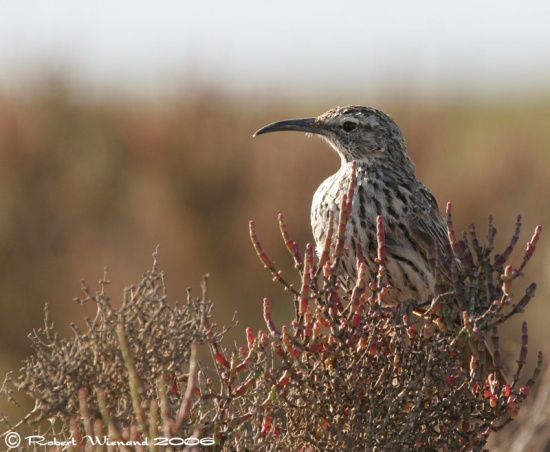
Certhilauda curvirostris
TAXONOMY
Alauda curvirostris Hermann, 1783, Cape of Good Hope.
OTHER COMMON NAMES
English: Long-billed lark; French: Alouette а long bec; German:
Langschnabellerche; Spanish: Alondra Picuda.
PHYSICAL CHARACTERISTICS
Male 7.5–7.9 in (19–20 cm); female 6.3–6.7 in (16–17 cm);
weight unknown. Males clearly larger than females, but sexes
do not differ in respect to plumage color or pattern. Plumage
brown-grayish, heavily streaked, breast marked with dark spots.
Species reminiscent of a thrush with a long, decurved bill.
Hind claw is long and straight.
DISTRIBUTION
Small strip from southern Namibia to southwestern South
Africa, Cape Province.
HABITAT
Coastal dunes and arid fields, avoids more rocky areas.
BEHAVIOR
Solitary or in pairs. Male performs spectacular aerial songdisplay,
characteristic for all Certhilauda species. Male first flies
low over the ground, then rises nearly vertically several feet
into the air and closes its wings before reaching the high point.
After that it nose-dives and descends vertically, not opening
the wings before coming close to the ground. Whistles while
descending; same song is also uttered from prominent perches.
FEEDING ECOLOGY AND DIET
Feeds on termites, grasshoppers, beetles, and ants, as well as on
seeds and berries. Uses long bill for digging. Since sexes differ
in size of bill, they probably exploit different food resources.
REPRODUCTIVE BIOLOGY
Monogamous. Breeds September through December; nest often
domed, clutch size ranges from two to three eggs; both
parents feed the young.
CONSERVATION STATUS
Not threatened. Common in its limited southwestern African
range. Range may have increased due to agriculture.
SIGNIFICANCE TO HUMANS
None known.
Other popular Animals
Photo Gallery of - Cape long-billed lark




 Animalia Life
Animalia Life